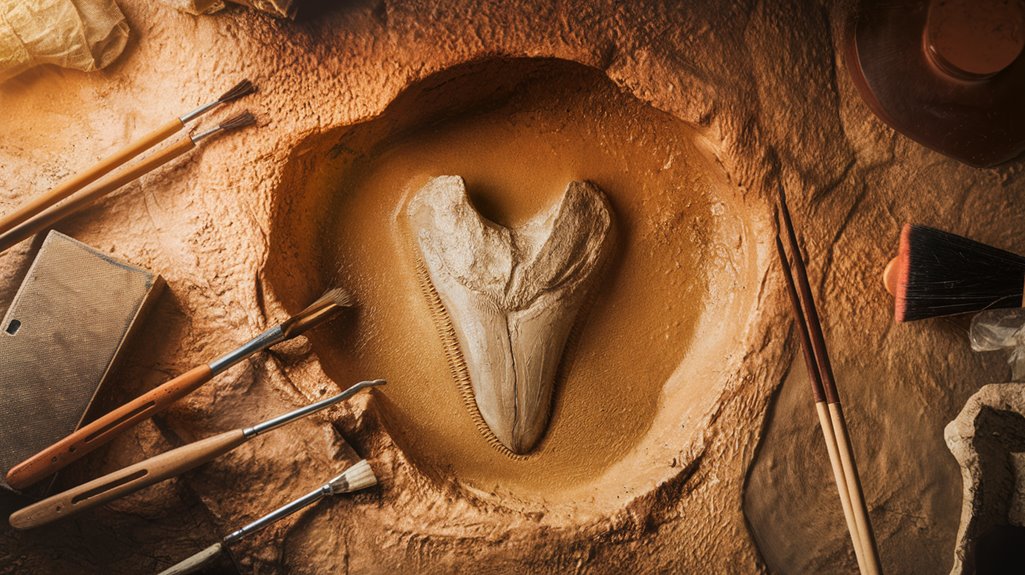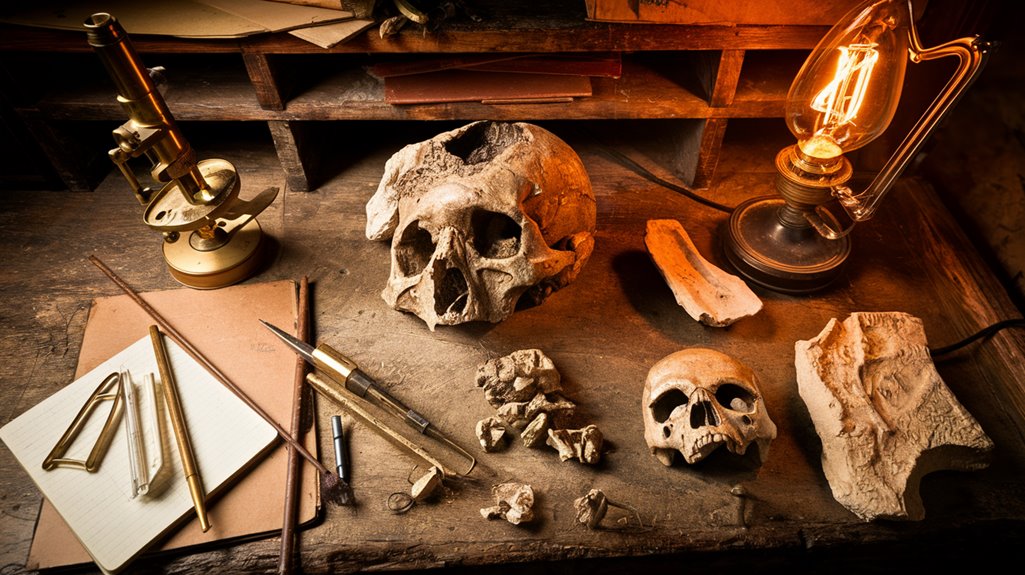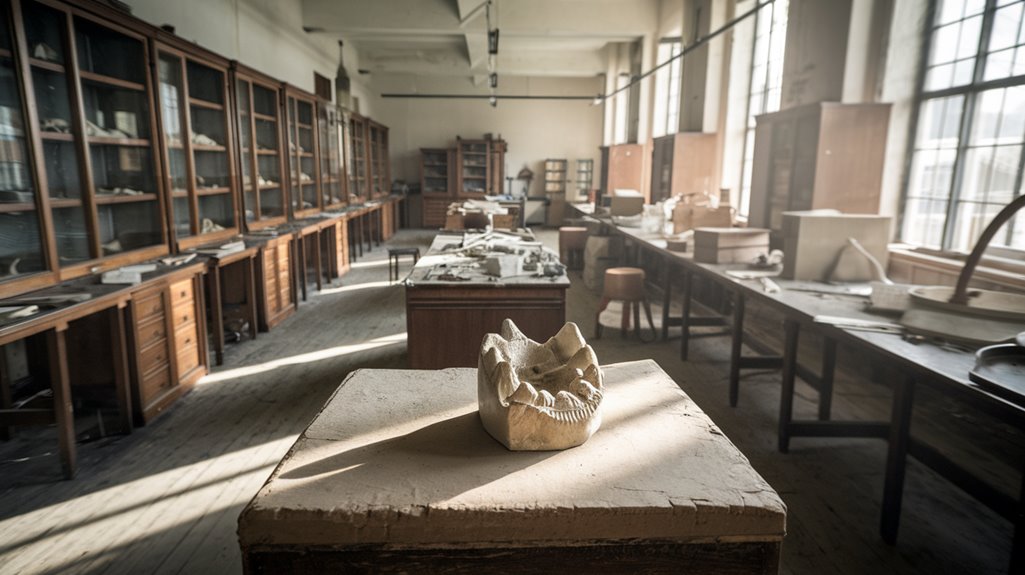The Peking Man: The Missing Link Lost to War
You might wonder if one of archaeology's greatest mysteries could have been prevented with a different wartime decision. When Japanese forces advanced on Beijing in 1941, scientists scrambled to protect the precious Peking Man fossils by shipping them to America. But the specimens never arrived at their destination, vanishing into the fog of war. What happened during those chaotic days has spawned decades of theories, treasure hunts, and tantalizing clues that continue to inspire scientific investigation.
The First Tooth: A Groundbreaking Discovery in 1921

A remarkable discovery in 1921 marked the beginning of our understanding of Homo erectus when Otto Zdansky unearthed two ancient teeth at Zhoukoudian, near Beijing.
You'll find the tooth significance extends far beyond their physical presence, as these specimens provided the first concrete evidence of ancient human ancestors in mainland Asia. The teeth revealed fascinating details about ancient diet and lifestyle patterns of early humans during the Pleistocene era. The Museum of Evolution at Uppsala University would become home to these important specimens.
When a third tooth was discovered in the 1950s, it further enhanced our knowledge of these prehistoric inhabitants. The detailed dental micro-wear analysis conducted in the 1980s provided crucial insights into their dietary habits.
The discovery sparked extensive research in paleanthropology and established Zhoukoudian as an essential archaeological site. These teeth would later prove invaluable, especially after most Peking Man fossils were lost during World War II.
Unearthing History: The Major Excavations at Zhoukoudian
Following the initial tooth discoveries, systematic excavations at Zhoukoudian transformed our understanding of human evolution in Asia. From 1921 to 1936, you'll find that archaeologists employed increasingly sophisticated excavation techniques, unearthing multiple skullcaps and thousands of artifacts.
The most significant breakthrough came in 1929 when Pei Wenzhong discovered a nearly complete skull cap, revolutionizing fossil preservation methods. Chemical analyses confirmed that burned fossils and ash deposits indicated early human fire control.
The site revealed 13 distinct layers spanning 700,000 years of history. Scientists uncovered over 100,000 stone tools, hundreds of animal species, and evidence of controlled fire use. The site's location 42 km southwest of Beijing made it easily accessible for continued research and excavation.
Dating methods showed Layer 10 formed around 462,000 years ago, while Layer 4 dated to 299,000 years ago. These discoveries made Zhoukoudian one of archaeology's most important sites for studying human origins.
The Mysterious Disappearance During World War II
While archaeologists made groundbreaking discoveries at Zhoukoudian, World War II's tumultuous events led to one of paleontology's greatest losses.
You'll find numerous disappearance theories surrounding the fate of Peking Man's fossils, which were packed into two wooden footlockers for transport to America in 1941. The wartime impacts proved devastating when Japanese forces attacked the SS President Harrison, the ship meant to carry these precious specimens to safety. The fossils were dated to be 300,000 to 800,000 years old before their disappearance.
Despite extensive searches and cash rewards, you won't find the original fossils today. Only six teeth, discovered years later, remain from the original collection. The site's groundbreaking work had involved Swedish geologist Johan Andersson who first connected the location to potential fossil discoveries in 1914.
While researchers continue investigating potential burial sites and following new leads, they must rely primarily on plaster casts and Weidenreich's detailed illustrations for their studies of this vital evolutionary find.
Scientific Impact: Reshaping Our Understanding of Human Evolution
Despite the tragic loss of most original fossils, Peking Man's scientific legacy revolutionized our understanding of human evolution. When discovered, these remains pushed back the evolutionary timeline by half a million years from what you'd previously known about Neanderthals. At 770,000 years old, they've helped establish humanity's deeper roots in the Middle Pleistocene period.
The discovery sparked intense debate about human ancestry. While scientists initially proposed an "Out of Asia" theory suggesting Peking Man was your direct ancestor, the "Out of Africa" theory later took precedence. The 200 Homo erectus fossils discovered at Zhoukoudian provided unprecedented insights into early human development. Modern geneticists strongly support the African-origin Chinese theory through extensive research.
However, you'll find Peking Man's influence still evident today – research suggests they interbred with your ancestors, contributing to modern Chinese populations' genetic makeup. The site's evidence of fire use and tool-making has also proved significant in understanding early human capabilities.
Beyond the Fossils: Cultural and Political Significance in China

Once scientists unearthed Peking Man in the 1920s and 1930s, the fossils evolved beyond their scientific significance into powerful symbols of Chinese national identity.
After 1949, Mao's government used cultural appropriation to transform Peking Man into a representation of communist ideals, depicting the ancient hominids as peaceful, cooperative beings. Premier Zhou Enlai directed researchers to reinterpret archaeological findings through a Marxist-Leninist lens.
The political symbolism intensified in the 1990s when Zhoukoudian became a patriotic education site. The disappearance of the original fossils in 1941 only intensified public interest and speculation about Peking Man's significance.
The figure has sparked debates about Chinese origins, with some scholars challenging the "out of Africa" theory in favor of a distinct Chinese evolutionary path.
Today, you'll see Peking Man's influence throughout Chinese culture, reinforcing national pride and unity.
You'll find Peking Man's legacy celebrated in state events, such as the millennium torch-lighting ceremony that marked the start of the "China century."
The Ongoing Search: Modern Efforts to Locate the Lost Specimens
Since the mysterious disappearance of Peking Man fossils in 1941, organized search efforts have intensified, particularly in the 21st century.
In 2005, Beijing's Fangshan District established a working committee, implementing diverse search strategies to track down the missing specimens, including four precious skulls and numerous skeletal remains.
The committee's public engagement initiatives included setting up a hotline that gathered 63 leads, with four deemed especially promising.
Before their disappearance, the fossils were carefully preserved in lens paper and cotton for their planned journey to New York.
They've systematically ruled out several locations, including the USA, Taiwan, and Korea.
While various theories persist – from Japanese interception to burial at sea – critics like Fang Zhouzi have questioned the scientific value of the search.
However, you'll find that the hunt continues, driven by the fossils' enduring significance in paleoanthropology and Chinese cultural heritage.
 plaster casts made by Franz Weidenreich before the original fossils vanished.
plaster casts made by Franz Weidenreich before the original fossils vanished.










